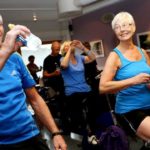 It’s widely accepted that maintaining physical and mental activity levels in our old age is hugely important to our wellbeing. Doing so can be easier said than done however, which with populations across the western world getting ever older ageing well is becoming ever more important.
It’s widely accepted that maintaining physical and mental activity levels in our old age is hugely important to our wellbeing. Doing so can be easier said than done however, which with populations across the western world getting ever older ageing well is becoming ever more important.
A recent study from the Norwegian University of Science and Technology (NTNU) explores not only the benefits of exercise for older people, but also the kind of exercises that are popular, and the reasons why people drop out.
Over five years the researchers tracked over 1,500 participants, who were all aged between 70 and 77, as they were assigned to one of either two distinct exercise groups or a third control group. The two exercise groups both undertook moderate or high intensity exercise twice per week, with most of the exercise undertaken on their own.
“We read through a total of 70 000 exercise logs from the first year of the study. It turned out that the participants to a great degree managed to train at the prescribed intensity. This is important to know, because it indicates that older people do not need to be monitored to be able to train at high intensity,” the researchers explain.
Exercise logs
Participants were asked to keep a log of when they exercised, how long it lasted for, the activities they performed, where they performed them, how hard they trained and whether they did so alone or with other people.
The data revealed that walking was far and away the most popular form of activity in both the moderate and high intensity training groups. Indeed, in the moderate intensity group it counted for over half of all exercise people did.
“Walking was the most popular activity in the high intensity group as well, but this group included more training in the form of cycling and jogging than participants in the moderate group. Achieving high intensity might have been easier with these types of activity for some participants,” the researchers explain.
The data also revealed that people nearly always prefer exercising outdoors, even in winter, with around 2/3 of their workouts conducted outside. This highlights the importance of providing adequate paths and trails for older people to exercise in their local area.
The team also identified some interesting gender differences however, suggesting that there isn’t a one sized fits all solution. For instance, men tended to exercise at a higher intensity, with most workouts consisting of either jogging, cycling or cross-country skiing. Women, by contrast, were more likely to go for dance and walking.
“We also found that older women exercise with others more often than older men do,” the researchers explain. “Whereas women chose to train with others for almost 60% of the sessions, men only chose to do this 40% of the time.”
Why people stop
Perhaps most important of all however is the insight the study gives into why people stopped exercising. Pleasingly, the data suggests that this figure is relatively low, with just 15% of the 1,500 participants dropping out over the three year study period, but even with this relatively low number, the researchers were able to identify some telltale signs.
For instance, individuals with lower education levels and memory problems were much more likely to stop exercising, whilst another intuitive marker is how active people were before they entered the study.
“Individuals who were physically active for fewer than 30 minutes a day were almost twice as likely to drop out from the study within three years as those who were more physically active. Low grip strength and poor fitness are other characteristics that make elders more likely to discontinue a training programme,” the team explain.
With active ageing so important on so many levels, hopefully the study will help policy makers ensure that people maintain an active lifestyle as they age.